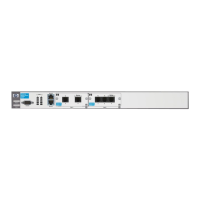13-7
Dynamic Host Configuration Protocol (DHCP)
Configuring a DHCP Server
■ You can also:
• configure a parent pool from which child pools import global settings
• assign a fixed DHCP address to a single client
• configure ping settings for the DHCP server
Excluding Static Addresses
Certain IP addresses in your network may be statically assigned to specific
hosts: for example, the router itself, the Ethernet interface, DNS and Web
servers, and switches. Often administrators reserve an entire block of
addresses for such devices. You must exclude all statically defined addresses
from the pool of addresses the router assigns clients.
To specify that a range of addresses cannot be assigned to DHCP clients, move
to the global configuration mode context and enter the following command:
Syntax: ip dhcp-server excluded-address <first A.B.C.D> [<last A.B.C.D>]
For example, your organization uses the first ten addresses on a subnet for
routers and switches and the second ten for servers. You enter:
ProCurve(config)# ip dhcp-server excluded-address 192.168.1.1 192.168.1.20
You can also exclude a single address:
ProCurve(config)# ip dhcp-server excluded-address 192.168.1.254
Use the no form of this command to remove an IP address from the
restricted list.
Creating a DHCP Pool
You should create a DHCP pool for each subnet that connects directly to the
ProCurve Secure Router and for which you want the router to act as a DHCP
server.
Use the following command to create the pool:
Syntax: ip dhcp-server pool <poolname>
Assign the pool an alphanumeric name meaningful within your network. For
example:
ProCurve(config)# ip dhcp-server pool LAN1

